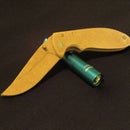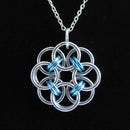Introduction: How to Make a Conductor's Baton
Starting in 8th grade (when I first got my lathe), I've made my band teacher (whoever that might be at the time) a baton every year. This would be pretty unexciting, except for the fact that I have the power of different materials on my side! So I decided to make an oak handled one the first year, cocobolo the second, and acrylic acetate the third. But what about the fourth year you ask? Well, my first teacher retired after freshman year, so the new guy's only gonna have me for three years. Which is lucky, because I don't have a fourth material lined up :P
WARNING: Please use any and all precautions necessary when working with power tools. There is a significant amount of sanding involved in this project, so please make sure you have access to a dust mask or filter of some sort. Also, if you choose to replicate this project using cocobolo, be aware that many people are allergic to its dust and you might be one of them. If in doubt, go with a wood you've worked with and know is safe.
Step 1: Materials
You will need:
- *Safety glasses
- *A dust mask
- A piece of material for the handle (3/4" in diameter, at least 3 inches or so long)
- A piece of 3/16" poplar dowel, 14" long or so
- A 3/16" drill bit
- *A lathe
*not pictured
Step 2: Some Prep Work and Drilling
Using a roughing gouge (or whatever tool you normally use), turn the wood down until it's completely cylindrical. You can easily check this by placing the tool on top of the spinning wood. If you hear chatter, it's still out of round.
Since I use the live center that came with my lathe, I thinned down the end of the blank a bit first so that, later on, I could still use the live center to steady the piece (this will make more sense in later pictures). If you have a cone center or your blank isn't all that long, you can skip this step.
Now, taking your 3/16" drill bit, measure how long you want your hole to be. Mark the end point with a piece of tape and start drilling.
Step 3: Shaping and Parting Off
Start shaping the handle however you want, keeping in mind that there's a hole running through the piece. As you get closer and closer to the diameter of the hole, start making very frequent size checks to make sure that you aren't getting too close. 1/64" to 1/32" is a good wall thickness to have at the tip of the handle.
Step 4: Finishing the Handle
I used to just take the newly parted off piece and sand the end down until it was as smooth as I wanted it. However, it's not very efficient, and if you don't rotate the piece evenly while sanding, you might end up with a bunch of flat spots. So I like to chuck up a piece of 3/16" steel rod or some wooden dowel, use friction to keep the handle in place, and sand and finish the end that way.
Step 5: Making the Shaft
PLEASE USE A DUST MASK FOR THIS STEP if you haven't been using one already.
Cut off a length of 3/16" dowel (I'm using poplar here, birch would also work nicely. Don't try to use pine as it will most likely splinter.) and put it in the chuck. Using a coarse grit of sandpaper (I used 60, which is probably the lowest I'd suggest going), start sanding the heck out of the dowel. You should end up with a smooth taper, where the end is about 1/16" in diameter or so. Once you've got the taper roughed out, progress through the grits until 600 or so, then use your standard finishing routine.
When you do this step, ALWAYS make sure you're restraining the end of the shaft in some way, as it will start to whip around and probably snap off and hurt you if you leave it unattended.
Step 6: Fitting and Gluing
Now insert the shaft into the handle and check for balance. Theoretically, the balance point should be exactly where the handle meets the shaft. Once you've got everything measured up, add a drop of CA or some other glue and join the two together.
Congratulations, you're done! Now go conduct a symphony, use it as a wand, or give it to a chem teacher to stir solutions. I'm not kidding about that one.













